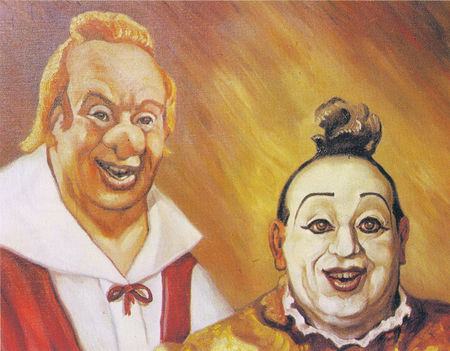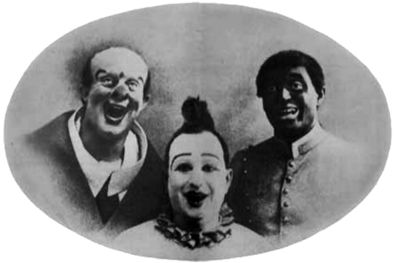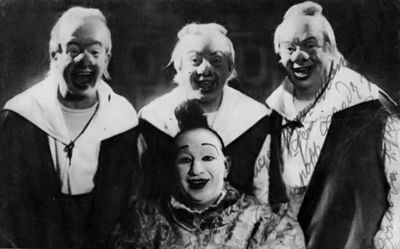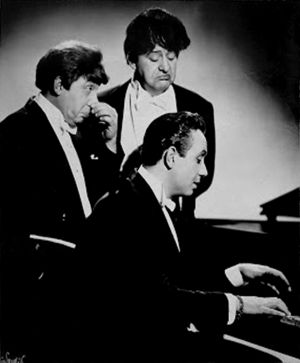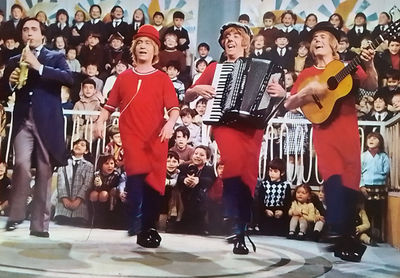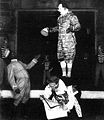The Aragón Family
From Circopedia
Clowns
By Dominique Jando
The Aragón family is one of Europe’s most prolific clown dynasties. A Spanish family with French circus ancestry, it has produced five generations of funnymen, some of whom have become major circus stars in Spain as well as abroad: Pompoff y Thedy, arguably the greatest Spanish clown duet of their generation, which morphed into The Pompoff Thedy Family with the third and fourth generations and have enjoyed an outstanding international career; and Gaby, Fofó y Miliki, from the fourth generation, and their children of the fifth generation, who became major stars on Spanish television.
POMPOFF THEDY FAMILY
From Pepino y Tonino To Pompoff y Thedy
The founder of the dynasty, Gabriel Aragón Gomez, was a former seminarian who had “run away and joined the circus,” and eventually became a clown under the name of Pepino. Gabriel married the equestrienneA female equestrian, or horse trainer, horse presenter, or acrobat on horseback. Virginie Foureaux (?-1930), daughter of the equestrian Jean-Philippe Foureaux, who came from one of France’s oldest circus dynasties: the Grand Cirque Foureaux had been established by Jacques Foureaux in 1805, and her family had been playing the fairgrounds long before the modern circus was created by Philip Astley in 1770. Gabriel and Virginie had fifteen children—and four sons among them. Little has been recorded of Arturo, the elder, who was probably significantly older than his more famous brothers: Emilio (later known as Emig—?-1946), Teodoro (later known as Thedy—1885-1974), and José-María (later known as Pompoff—1886-1970).At the end of the nineteenth century, Gabriel Aragón created a successful clown duet with his elder son Arturo. As Pepino y Tonino (Arturo’s stage name), they acquired a strong reputation in Spain and all over Europe. Gabriel’s other sons participated in their father’s act as they grew up (the act was sometimes billed as the Aragón Family), but in 1909, José-María and Teodoro decided to take their independence and create a clown act of their own. They flopped: At twenty-four and twenty-two respectively, they probably still lacked the maturity necessary to carry a comedy act by themselves—especially in a country that appreciated good clowning, and where great clowns were aplenty!
The brothers split, and Teodoro went to the United States, where he worked in an acrobatic act. José-María became a small-time circus producer, and toured a modest show in neighboring Morocco, then under the joint rule of Spain and France. In 1912, Morocco became a French protectorate, and José-María ended his circus tours in that country. The following year, Teodoro returned from his engagement in the United States, and he and José-María decided to revive their clown act.They debuted in 1913 in Valencia, and this time, the Hermanos Aragón (the Brothers Aragon), as they were originally known, who had apparently gained valuable life experience and maturity, met with unmitigated success.
They soon changed their name for Pompoff y Thedy: José-María was Pompoff, the classic whiteface clownGeneric term for all clowns and augustes. '''Specific:''' In Europe, the elegant, whiteface character who plays the role of the straight man to the Auguste in a clown team., and Teodoro was Thedy, the augusteIn a classic European clown team, the comic, red-nosed character, as opposed to the elegant, whiteface Clown.. Their association would last a half-century, and Pompoff y Thedy would become Spain’s most celebrated clowns, their fame spreading all over Europe and eventually to America. During the 1920s, the duo became a trio, with the addition of their brother Emilio, who became the second augusteIn a classic European clown team, the comic, red-nosed character, as opposed to the elegant, whiteface Clown.. Under the stage name of Emig, Emilio created a "Cuban" augusteIn a classic European clown team, the comic, red-nosed character, as opposed to the elegant, whiteface Clown. character that he played in blackface, in the American old minstrel tradition.
José-María had two sons, José and Victor, and Teodoro had one son, Emilio. In the 1930s, after Emig had left the trio, José (1912-1993), known by the improbable stage name of Nabucodonosorcito (or Pepe…) and Emilio (known as Zampabollos) were added to the act. Together, the family continued their brilliant European career, until it became constrained to Spain with the advent of WWII. In 1939, Pompoff, Thedy, Nabucodonosorcito and Zampabollos starred in a short movie directed by Octavio F. Roces, and titled Pompoff, Thedy y Compañía, which was shown as an opener with Carlos Fernández Cuenca’s feature film, Leyenda Rota.
Pompoff, Thedy & Company in America
After WWII, the economic situation in Spain was particularly difficult, and in 1952, Teodoro took the family back to the United States, where they settled and worked successfully in variety for the next fifteen years. (American circus clowning, at that time, was still limited to sight gags performed in a three-ring format by groups of generally anonymous and over-made-up augustes—whereas the European style of Pompoff, Thedy and family, who spoke and were excellent musicians, was closer to American vaudeville or burlesque comedy acts.)
In America, Pompoff, Thedy, José and Emilio, and José's brother, Victor, were billed as Pompoff, Thedy & Family, Spain’s Royal Family of Comedy. Their stage appearance changed drastically: Pompoff’s European clown characteristics—his whiteface and his ornate, sequined costume—disappeared to give way to black tails and white tie, an outfit adopted by all members of the act, with various degrees of fitting for José and Emilio. Their augusteIn a classic European clown team, the comic, red-nosed character, as opposed to the elegant, whiteface Clown. make-ups, too, although never very strong (following in this the European tradition), became simplified to a bare minimum; only the augustes’ animated wigs and bulbous noses differentiated them from conventional vaudeville comedians.Pompoff and Thedy worked mostly, at first, as musical accompanists to the clown trio animated by their sons, José and Emilio, who had been joined by Victor, José's younger brother. Victor worked as their straight man, while Emilio was the principal augusteIn a classic European clown team, the comic, red-nosed character, as opposed to the elegant, whiteface Clown. to his brother José—whose mute character was reminiscent of Harpo Marx’s, his evident inspiration. Eventually, Pompoff and Thedy retired from the act, which became a trio known as The Pompoff Thedy Family, with Emilio, José and Victor.
Over the years, what was left of their augusteIn a classic European clown team, the comic, red-nosed character, as opposed to the elegant, whiteface Clown. make-ups disappeared, and their costumes became better fitted—yet they remained unmistakably a trio of clowns. Their physical appearance, however, had a special cachet and was quite original, even compared to other European clowns; it allowed them to fit more efficiently on the American variety scene of the time, which still kept a few glorious remnants of the defunct Vaudeville era.
The Pompoff Thedy Family were featured in many variety shows, including the highly successful Judy Garland’s show in 1956-57 at the legendary Palace Theatre on Broadway (which was then celebrating its reopening), and the long-running Folies Bergère revue at the Tropicana Hotel in Las Vegas. On television, they appeared on several Ed Sullivan Show, the most popular variety show on American television in the 1960-70s; on Jackie Gleason’s American Scene Magazine on CBS; on NBC’s The Kraft Music Hall; and on ABC’s The Hollywood Palace, among others.
The Pompoff Thedy Family: The Last Decades
In 1967, the family returned to Spain and settled in Madrid. That year also marked José-María and Teodoro official farewell to the ring: Assisted by José, Emilio and Victor, the still beloved Pompoff and Thedy gave their last performance at Madrid’s legendary Circo Price, in their traditional clown regalia, Pompoff in whiteface and sequined costume, and Thedy in traditional augusteIn a classic European clown team, the comic, red-nosed character, as opposed to the elegant, whiteface Clown. make-up. José-María died in Madrid, his birthplace, three years later, in 1970. Teodoro followed him on December 30, 1974 (he had been born in Nice, France, on February 25, 1886). Both are buried in Madrid.The Pompoff Thedy Family trio, on the other hand, resumed their European career, working mostly in variety with a few appearances in circus buildings. In 1979, they participated in the 6th International Circus Festival of Monte Carlo, where they obtained a great success, unfortunately eclipsed by the triumph of another great clown who did most of his career in variety, George Carl. It was in fact the first time that clowns had been truly successful at the Festival (if one excepts Charlie Rivel at the first festival, whose "Gold Clown" award was mostly a tribute to a long and exceptionally brilliant career that was by then on the vane). Yet the Pompoff Thedy Family were sadly forgotten by the Jury of the festival, enthralled as it was by the remarkable and unexpected performance of George Carl.
After Emilio left the act (he died in Chicago, where he had retired, on November 28, 1985), Victor took his place, with his young and talented son, Sandro, acting as the trio’s straight man. By then, José-Nabucodonosorcito-Pepe was in his seventies, still efficient, funny, and immensely loveable, still the central comic character of the Pompoff Thedy Family—who had lost none of their remarkable comic and musical talents over the many years they spent creating laughter in Europe and America.
José Aragón (his full name was José Aragón Hipkins) eventually retired from the stage and the ring in the early 1980s. In 1991, he was presented with the Gran Premio del Circo (Spain’s National Circus Award) by the Spanish Ministry of Culture, as a tribute to his long and exceptional career. He died in Madrid on March 22, 1993, at age eighty-one. With his passing, the Pompoff Thedy Family disappeared forever.
GABY, FOFÓ Y MILIKI
Gaby (Gabriel Aragón Bermudez, 1920-1995), Fofó (Alfonso Aragón Bermudez, 1923-1976), and Miliki (Emilio Aragón Bermúdez, 1929-2012) were Spanish television stars of first magnitude in the realm of children television from to 1972 to 1983, and are remembered by a whole generation as Los Payasos de la Tele ("The TV Clowns"). The group changed slightly over the years with the subsequent additions of Fofito (Alfonso Aragón Sac, born in 1949, son of Fofó), Milikito (Emilio Aragón Alvaréz, born in 1959, son of Miliki), and finally, Rody (Rodolfo Aragón Sac, born in 1958, son of Fofó), the passing of Fofó in 1976 and the retirement of Miliki in 1981.
The Hermanos Aragón
Gaby, Fofó and Miliki were the sons Emilio Aragón Foureaux (Emig) and his wife Rocío, née Bermúdez Contreras, an equestrienneA female equestrian, or horse trainer, horse presenter, or acrobat on horseback.. Gabriel was born July 3, 1920, in Madrid; Alfonso was born February 7, 1923, in Ulea, in the Murcia region; Emilio was born November 4, 1929, in Carmona, in the Seville province. Heirs to a famous and successful clown dynasty, they were somehow destined to follow in their forebears’ footsteps.Being the oldest of the three sons, Gaby, was the first to embrace the career in 1934, at age fourteen, making his solo debuts under the name of Homobono—thus continuing the well-established family tradition of odd stage names. He was joined five years later (1939) by his siblings, and they went on to perform together. They adopted the stage names of Gaby, Fofó, and Emilin; soon, Emilio/Emilin would change his name to Miliki.
Gaby performed as the straight man to his brothers who, wearing limited makeup and (later) long red T-shirts reminiscent of Charlie Rivel’s costume, were the augustes. In the good European clown tradition, the three brothers were accomplished musicians, and even singers. Billed as Los Hermanos Aragón, they performed sometimes with their sister Rocío (1925-2018), a classic flamenco dancer who pursued later a career as a choreographer on TVE (Spanish Television).
The trio made its debut in 1939 in Madrid at Circo Price, under the management of Mariano Sánchez Rexach. Then in 1946, the economic situation in Spain being particularly dire, the three brothers emigrated to Latin America. They first settled in Spanish-speaking Cuba. It is there, in 1949, that they had their television debuts. Their appearances on Cuban television expanded their popularity to the rest of Latin America. In 1965, they re-settled in Puerto Rico, where they broadcasted a daily show titled El Show de las 5 ("The Five o’clock Show"), which became extremely successful.
Television Stars
They moved to Buenos Aires, Argentina, in 1971, where they starred on Channel 13 (La Trece) on a musical program titled El Zapato Roto ("The Broken Shoe"). It was a hit and was soon renamed El Show de Gaby, Fofó y Miliki. They had an uncanny connection with children that made the program extremely popular with young audiences. Alfonso Aragón Sac, Fofó’s son, joined his father and uncles in the group as Fofito. In 1972, the brothers starred in an Argentinean movie musical, Había una vez un circo ("Once upon a time, there was a circus"), and in 1973, Gabriel and Emilio were featured in another movie, Los Padrinos ("The Godfathers").
Their reputation had crossed the ocean, and in 1972, they returned to Spain at the request of TVE, the Spanish Television state company, to lead a new program called El Gran Circo de TVE ("TVE’s Big Circus"), geared to the children audience. It was an unprecedented success that morphed into a true phenomenon. The Aragóns became known in Spain as Los Payasos de la Tele ("The TV Clowns"). They also solidified their fame with the production of several children songs records.Around 1975 (before the death of Fofó on June 22, 1976), Emilio Aragón Álvarez, Miliki's son, became part of the group as Milikito—who was at the beginning a silent augusteIn a classic European clown team, the comic, red-nosed character, as opposed to the elegant, whiteface Clown. who communicated with the help of a cowbell, like Harpo Marx with his horn. (Milikito quickly went on to speak, albeit sparsely!) Then in 1981, Miliki, the last augusteIn a classic European clown team, the comic, red-nosed character, as opposed to the elegant, whiteface Clown. of the original trio and the most popular of the brothers, left the program; Rody (Rodolfo Aragón Sac), the youngest son of Fofó, joined the group in black face—as Emig, his grandfather, had done in the early days of the Pompoff Thedy Family.
But with the disappearance of Fofó and the retirement of Miliki, the program quickly lost steam. Furthermore, Spain had changed drastically after the end of Francisco Franco’s dictatorship in 1975, and El Gran Circo de TVE had been a regular feature since 1972. It had indeed adapted to the times, but times were now changing faster. In 1982, it was revamped and renamed El loco Mondo de los Payasos ("The Crazy World of Clowns"); a change of identity that was perhaps a death warrant: It was eventually cancelled the following year.
Epilogue
The ever-resilient Gaby, with Fofito, Milikito and Rody, went on tour for the next two years with a circus show titled El Fabuloso Mondo del Circo ("The Fabulous World of The Circus"), before finally calling it quits. Miliki went on to record music albums with his daughter, Rita Isasema. With the advent of private television in Spain, he returned to the small screen to host children's programs with his daughter in 1990-91 and, in 1993, they relaunched on TVE El gran circo de TVE, which lasted until 1995. Finally retired from performing, Miliki published a novel under the pen name of Emile A. Foureaux, La Providencia (2008).
Gaby passed away on January 10, 1995, and Miliki on November 18, 2012. Although the younger Aragóons subsequently built careers for themselves on television (albeit not as clowns), sadly, the passing of Gaby and Miliki marked the end of the fabled Aragón clown dynasty. However, it survives through the numerous appearances on television of the Pompoff Thedy Family and, of course, Gaby, Fofó, Miliki and their sons, and also in the realm of magical souvenirs for those who have been lucky to see them perform.
See Also
- Video: The Pompoff Thedy Family, clown entrée, in the Ed Sullivan Show (1960)
- Video: The Pompoff Thedy Family, clown entrée, in ABC's Hollywood Palace (1964)
- Video: The Pompoff Thedy Family, musical entrée, at the Royal Circus in Stockholm (1977)
- Video: Gaby, Fofó y Miliki, clowns, in their TV show, El Gran Circo de TVE (1974)
- Video: Gaby, Miliki, Fofito y Milikito, clown entrée, in El Gran Circo de TVE (c.1980)
